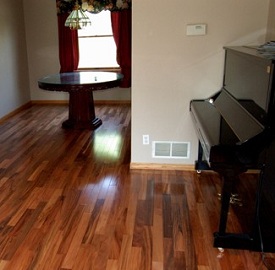
One advantage that engineered flooring has over many like bamboo floors or cork flooring is that you can install it in any room, either above or below ground. It is also generally designed to be installed quickly and easily.
The Ease of Engineered Hardwood Installation With many engineered hardwood flooring lines, there is no need for nailing the boards down to the subfloor. This has a couple of implications. First, that a concrete slab subfloor is a suitable substrate on which to install engineered hardwood, unlike solid hardwood. Second, that many engineered hardwood flooring lines can either be floated, as you would a laminate floor, or glued down.
Engineered Hardwood Flooring Installation As long as you subfloor is clean, level and dry, engineered hardwood flooring is a versatile option that can yield successful results without the need to consider whether or not a subfloor is suitable for a nail-down installation. In the case of a floating engineered floor, remember to use a reliable vapor barrier between the subfloor and your flooring. The adhesives used in a glue-down option often add the advantage of acting as a built-in vapor barrier. Different manufacturers may offer varying installation options. Ask the professionals about the details on your chosen line of engineered hardwood flooring. Locking Systems For Engineered Hardwood Flooring Most types of engineered hardwood feature a tongue and groove locking system. These are designed for a level of precision that makes for a refined flooring surface that is free of unsightly gaps between the boards. Once again, versatility and practicality are the distinguishing features of engineered hardwood flooring.
Often, these types of locking systems allow you to take up the boards at a later date when necessary, if you’ve chosen a floating floor option. So, you can take your floor with you when you’re moving house, or allow you to more easily replace any damaged boards. When making a purchase, it is a good idea to ask whether your chosen line of engineered hardwood flooring allows for this feature.
Radiant Heat and the Engineered Hardwood Floor Radiant heat is a welcome feature to many households and commercial interiors. But, when choosing a flooring option, it is important to note the impact that radiant heating may have in the short term as well as the long term. For solid hardwood, radiant heat can have a significantly negative effect; the radiant heating can severely dry out the hardwood, which in turn causes the boards to warp and cup as they would if they were exposed to excessive moisture.
Luckily, engineered hardwood has been designed to counteract this tendency, just as it has in the case of humidity and dampness in a below-grade or non-environmentally controlled interior. Once again, the core of the engineered floor expands and contracts accordingly, while preserving the structural stability of the board and the attractiveness of the top layer.
Do Your Homework Before Making a Choice Whether you choose to attempt an engineered hardwood flooring installation on your own or decide to call on a flooring contractor, it’s a good idea to be at least somewhat familiar with what the process entails. Make sure you are choosing the right flooring material for your home, especially if you’ll be using a radiant heating system. It’s always better to ask than to make a mistake due to insufficient knowledge.





